

Esopedia. Map of World Mythology. Myth, Legend, Folklore, Ghosts. Apollo and the Greek Muses Updated July 2010 COMPREHENSIVE SITES ON MYTHOLOGY ***** The Encyclopedia Mythica - SEARCH - Areas - Image Gallery - Genealogy tables - Mythic Heroes Probert Encyclopaedia - Mythology Gods, Heroes, and MythDictionary of Mythology What is Myth?

MESOPOTAMIAN MYTHOLOGYThe Assyro-Babylonian Mythology FAQ Sumerian Mythology FAQ Sumerian Mythology Sumerian Gods and Goddesses Sumerian Myths SUMERIAN RELIGION Mythology's Mythinglinks: the Tigris-Euphrates Region of the Ancient Near East Gods, Goddesses, Demons and Monsters of Mesopotamia The Assyro-Babylonian Mythology FAQ More info on Ancient Mesopotamia can be found on my Ancient River Valley Civilizations page. GREEK MYTHOLOGYOrigins of Greek MythologyGreek Mythology - MythWeb Greek-Gods.info (plus a fun QUIZ)Ancient Greek Religion Family Tree of Greek Mythology Greek Names vs. Religion, Mythologie et Autres Récits. Mythology. Mythologie. Recurring themes in mythology. Mythology. Mythology. Mythology. Mythology. Mythology. Mythology. Mythology.
Mythologie du monde. Natura Mythica Deios. Mythologies. Mythe. Mitologia. Mythology. Mythology. Mythologie. Mythos. MYTHOS. Mythos. Mythology. Mythology. Mythologie. Mythology. Mythology. Mythology. Mythology. Mythology & Spirituality. Mythology or History? Mythology. Mythology. Mythologie et textes. MYTHOS. MultiCultural & Reference. Mitologia – Tanogabo.it. Myths and Legends – Telling the stories of the past in the language of the present. Godchecker.com - Your Guide To The Gods. Comparative Mythology. Epic of evolution. A narrative that blends religious and scientific views of cosmic, biological and sociocultural evolution in a mythological manner In social, cultural and religious studies, the "epic of evolution" is a narrative that blends religious and scientific views of cosmic, biological and sociocultural evolution in a mythological manner.

According to Taylor's Encyclopedia of Religion and Nature, an "epic of evolution" encompasses the 14 billion year narrative of cosmic, planetary, life, and cultural evolution—told in sacred ways. Not only does it bridge mainstream science and a diversity of religious traditions; if skillfully told, it makes the science story memorable and deeply meaningful, while enriching one's religious faith or secular outlook.[1] History[edit] "Epic of evolution" seems to have originated from the sociobiologist Edward O. Naturalistic and liberal religious writers have picked up on Wilson's term and have used it in a number of texts. Narrative[edit] The epic as myth[edit] Dr. E.
Egyptian. 10 Lesser-Known Egyptian Gods That Are Absolutely Terrifying. I was in Egypt a few weeks ago.
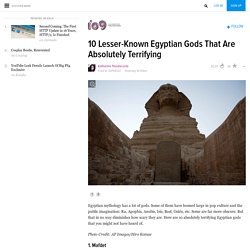
Here's another relief from inside the temple at Esna, showing Thoth and Horus anointing the king, along with a goddess I believe to be Menhit. The interior of the temple is quite well preserved as it was deliberately buried to protect it. Here you can see the temple is significantly lower than the contemporary city. From this angle you can see the relief of Menhit pictured in the article. There was also a statue of Menhit in the courtyard outside. Egypt is extremely quiet at the moment so I was able to freely explore all the temples I visited. Many of these sites are astonishingly well preserved considering their age, and there are some fascinating reliefs, some in obvious places, but others hidden away where you really have to look for them.
Gilgamesh. Gilgamesh, Epic of. From New World Encyclopedia The Epic of Gilgamesh is an epic poem from Babylonia and arguably the oldest known work of literature.
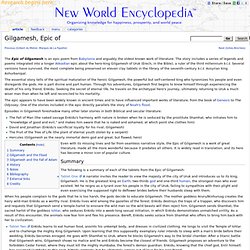
The story includes a series of legends and poems integrated into a longer Akkadian epic about the hero-king Gilgamesh of Uruk (Erech, in the Bible), a ruler of the third millennium B.C.E. Several versions have survived, the most complete being preserved on eleven clay tablets in the library of the seventh-century B.C.E. Assyrian king Ashurbanipal. Greek Mythological. Greek. THEOI GREEK MYTHOLOGY, Exploring Mythology & the Greek Gods in Classical Literature & Art.
Mythologie Grecque et Latine. La mythologie grecque, Dieux Olympiens. Deo Mercurio. Family tree of the Greek gods. Family tree of gods, goddesses and other divine figures from Ancient Greek mythology and Ancient Greek religion The following is a family tree of gods, goddesses and many other divine and semi-divine figures from Ancient Greek mythology and Ancient Greek religion.
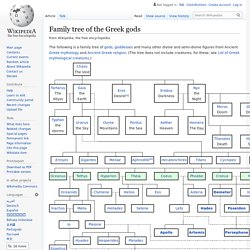
(The tree does not include creatures; for these, see List of Greek mythological creatures.) Key: The essential Olympians' names are given in bold font. Key: The original 12 Titans' names have a greenish background. See also. Mitologia greco-romana: indice di miti e leggende. See also CONSTELLATIONS The god Ocean , holding a cornucopia.
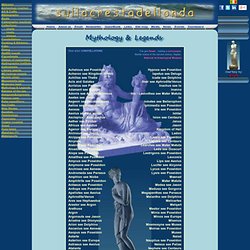
La Mètis et l’hybris (ou hubris ou ubris) La mètis désigne en grec, non pas l’intelligence, mais une forme particulière d’intelligence et de pensée, fondée sur la ruse, l’astuce, le stratagème, mais aussi la dissimulation, la tromperie voire même le mensonge.

La mètis, rappelle Jean-Pierre Vernant, s’épanouit dans la pensée grecque archaïque qui ne fait pas de distinction entre l’être et le paraître, entre le monde des Idées et le monde sensible. Elle s’applique donc à des réalités mouvantes, instables et ambiguës, qui ne se prêtent ni au raisonnement rigoureux, ni à la mesure précise, ni à la mise en système. Elle renvoie aussi bien au savoir-faire de l’artisan, qu’à l’adresse du navigateur évitant les écueils, ou à l’habileté du sophiste. Il Daimon nella tradizione mitologica greca - Tracce di studio. Il termine daimon (Δαίμων), oggi tradotto comunemente demone, non va confuso con l’idea di essere demoniaco che si ha dall’avvento del cristianesimo.
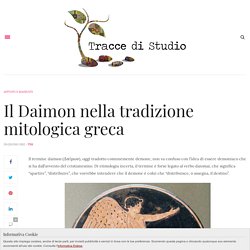
Di etimologia incerta, il termine è forse legato al verbo daiomai, che significa “spartire”, “distribuire”, che vorrebbe intendere che il demone è colui che “distribuisce, o assegna, il destino”. Hekate Trigemina. Culto, poteri e iconografia – La ceramica antica. Chi mi conosce sa che ho una vera passione per il mito greco e che nel cuore ho personaggi del calibro di Aiace Telamonio, Circe e Medea.
Un altro personaggio che sento vicino è la mistica Hekate. Approfondiamo insieme la sua conoscenza e immergiamoci nella sua grandezza divina… Roman. Mythologie, héros, dieux. Pantheon. Menrva Minerva Wisdom Goddess Arts Goddess Inventor Goddess Etruscan Goddess roman goddess pagan gods and goddesses Roman Gods and goddesses wiccan wicca paganism pagan Thalia Took. Menrfa, or Menrva, is the Etruscan name of the Goddess of Wisdom and the Arts, who in Rome would be known as Minerva, and who corresponds to the Greek Athene.
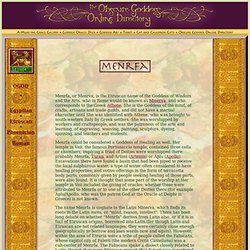
She is the Goddess of the mind, of crafts, artisans and trade guilds, and did not have a martial character until She was identified with Athene, who was brought to south-western Italy by Greek settlers. She was worshipped by workers and craftspeople, and was the patroness of the arts and learning, of engraving, weaving, painting, sculpture, dyeing, spinning, and teachers and students. Menrfa could be considered a Goddess of Healing as well. Mythologie celtique.
Celtic Myths. We can see this anthropomorphization clearly with the god Lugh, who gives his name to the Irish summer festival of Lughnasadh. In the earliest Irish myths he is clearly a deity.
Norse Mythology for Smart People - The Ultimate Online Guide to Norse Mythology and Religion. Mahabharata The Great Spiritual Epic Of All Time by Krishna Dharma. The Bhagavad Gita. Japanese mythology. Japanese mythology. Japanese mythology, body of stories compiled from oral traditions concerning the legends, gods, ceremonies, customs, practices, and historical accounts of the Japanese people. Most of the surviving Japanese myths are recorded in the Kojiki (compiled 712; “Records of Ancient Matters”) and the Nihon shoki (compiled in 720; “Chronicles of Japan”).
These works tell of the origin of the ruling class and were apparently aimed at strengthening its authority. Therefore, they are not pure myths but have much political colouring. Encyclopedia of Myths. Encyclopedia Mythica. Mythologies du monde entier. Mythfs.gif (1825×1243) Mythes sur la création et la destruction. Mythes et Légendes. Mythes, contes et légendes. Myths and Archetypes. The pleiades in mythology. In the clear and unpolluted night skies of antiquity the Pleiades star cluster was an object of wonder and interest.
Les mythes modernes. Modern Myths. What Is A Modern Myth? I’ve had many discussions with people over the past few years about why myth is important. Much of these discussions come down to a misunderstanding about what the word “myth” means, so what could have been an interesting discussion about politics, permaculture, literature (or sex or food for that matter) becomes a lesson in semantics. I’d like to avoid rehashing that argument, and toward that end, give a definition of myth that all of us can wrap our heads around.
And I hope as a result of it you will see why this is such a crucial issue to explore, as it has relevance in regard to every other discipline of study. 18 Classic Myths Explained with Animation: Pandora’s Box, Sisyphus & More. Greek myths have an incredible shelf life. We may not retain all the players’ names or the intricacies of the various plot lines, but the creative punishments the gods—Zeus, in particular—visited upon those who displeased them have provided modern mortals with an enduring shorthand for describing our own woes. Tempted to sneak a peek inside a lover’s diary? Take a teeny swig from the liquor cabinet whilst housesitting? Go snooping in your teenager’s Internet history? But if curiosity compels you to explore beyond the famous punchlines of mythology’s greatest hits, TED-Ed’s animated Myths from Around the World series is a recommended rummage.
Piramo e Tisbe. Da Wikipedia, l'enciclopedia libera. Mito[modifica | modifica wikitesto] Les Mythes et les Religions. Le jardin d’Eden est le verger dans lequel on rencontrait deux arbres extraordinaires : l’arbre de la connaissance et l’arbre de la vie et de la mort. Ponce de Leon and the Fountain of Youth Myth. The Fountain of Youth myth is one that has been told for thousands of years all around the world. It is a mystical story of a spring that restores youth to all who drink from it or bathe in its waters. The myth is so pervasive that different cultures across the world have their own versions and tales. But here in the Western world, perhaps the most well-known Fountain of Youth tale is the one that stars a famous Spanish explorer by the name of Juan Ponce de León.
The Ponce de León Fountain of Youth Myth Though stories of a Fountain of Youth can be traced all the way back to 5th century BCE Greece and across diverse cultures for the thousands of years since, the legend of such a fountain became particularly prominent in the 16th century when it was first associated with Juan Ponce de Leon. Legend has it that it was on that history-making voyage to Florida that the adventurous Ponce de León was actually searching for the Fountain of Youth. Contes merveilleux Contes de fées Contes populaires. Joseph Campbell.
Joseph Campbell Myth-Hero Cycle. Joseph Campbell. Joseph Campbell. Joseph Campbell on Myth and Religion. JCF: Home – Joseph Campbell Foundation: a Network of Information – a Community of Individuals. What Makes a Hero: Joseph Campbell’s Seminal Monomyth Model for the Eleven Stages of the Hero’s Journey, Animated. By Maria Popova “It has always been the prime function of mythology and rite to supply the symbols that carry the human spirit forward.”
Nearly four decades before Joseph Campbell (March 26, 1904–October 30, 1987) refined his enduring ideas on how to find your bliss and have fulfilling life, the legendary mythologist penned The Hero with a Thousand Faces (public library) — his seminal theory outlining the common journey of the archetypal hero across a wealth of ancient myths from around the world. Campbell’s monomyth model has since been applied to everything from the lives of great artists to pop-culture classics like Star Wars. Joseph Campbell: Schizophrenia and the Hero Myth. Spotify. Monomyth. Joseph Campbell's monomyth, or the hero's journey, is a basic pattern that its proponents argue is found in many narratives from around the world. This widely distributed pattern was described by Campbell in The Hero with a Thousand Faces (1949).[1] Campbell, an enthusiast of novelist James Joyce, borrowed the term monomyth from Joyce's Finnegans Wake.[2] Campbell held that numerous myths from disparate times and regions share fundamental structures and stages, which he summarized in The Hero with a Thousand Faces: A hero ventures forth from the world of common day into a region of supernatural wonder: fabulous forces are there encountered and a decisive victory is won: the hero comes back from this mysterious adventure with the power to bestow boons on his fellow man.[3] A chart outlining the Hero's Journey.
Summary[edit] The Hero's Journey by Joseph Campbell. The Hero's Journey on The Alchemist Paulo Coelho. Myths of light by Joseph Campbell.